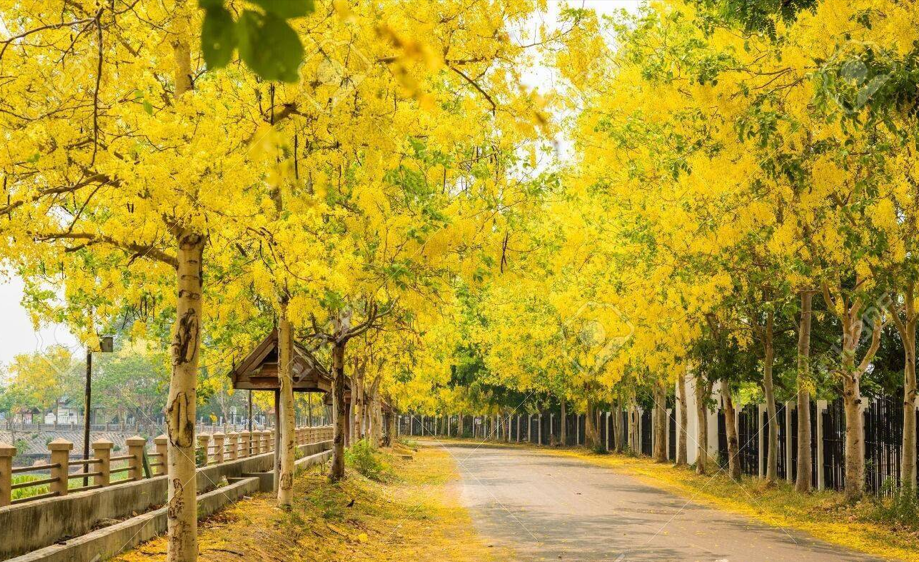Cassia fistula, commonly known as the golden shower tree, is
a medium-sized deciduous tree renowned for its striking yellow flowers and
various environmental and cultural benefits.Un Mondo Ecosostenibile+6Properly Rooted+6PMC+6
Origin and Native Regions
Cassia fistula is native to the Indian subcontinent and
adjacent regions of Southeast Asia. Its native range extends from the east
across India to Myanmar, Thailand, and south to Sri Lanka and southern
Pakistan. Wikipedia+2Un Mondo Ecosostenibile+2mazharbotanicgarden.com+2
Environmental Benefits
Beyond its ornamental appeal, Cassia fistula offers several
environmental advantages:
- Erosion
Control: The tree's robust root system helps stabilize soil, reducing
erosion, especially in tropical and subtropical regions.Un Mondo Ecosostenibile
- Biodiversity
Support: The flowers attract various pollinators, including bees and
butterflies, while the seeds serve as food for certain wildlife species. Default
- Shade
Provision: The tree's dense canopy offers shade, contributing to
temperature regulation in urban areas and providing relief from heat.
Cultivation and Habitat Preferences
Cassia fistula thrives in tropical climates and prefers
well-drained soil, though it tolerates various soil types, including sandy,
loamy, calcareous, and red volcanic soils. It is commonly found in open
grasslands at low to medium altitudes and in light forests below 400 meters in
regions like Java and the Philippines. mazharbotanicgarden.comGlobinMed
Uses
Beyond its environmental contributions, Cassia fistula has
several notable uses:
- Ornamental:
Its vibrant flowers make it a popular choice for landscaping and urban
beautification.Properly Rooted
- Medicinal:
Various parts of the tree, including the fruit pulp, leaves, and seeds,
are used in traditional medicine to treat ailments such as constipation,
diabetes, and liver problems. The fruit pulp, in particular, is known for
its mild laxative properties. Default+1mazharbotanicgarden.com+1
- Timber:
The wood is valued for its strength and durability, making it suitable for
constructing furniture, cabinets, and other wooden items. Default
Conclusion
Cassia fistula is more than just an ornamental tree; it
plays a vital role in environmental conservation by preventing soil erosion,
supporting biodiversity, and providing shade. Its adaptability to various soil
types and climates, combined with its numerous uses, underscores its
significance in both natural ecosystems and human societies.
References
Here are the sources used to extract and compile the
information about Cassia fistula:
- Plants
of the World Online – Kew Science
- Source:
https://powo.science.kew.org/taxon/484507-1
- Details:
Provides taxonomic information and the native distribution of Cassia
fistula, confirming its origin in South and Southeast Asia.
- GlobinMed
– Traditional and Complementary Medicine Database
- Source:
https://globinmed.com/conservation/cassia-fistula-l-62843
- Details:
Offers detailed information on the environmental conditions where Cassia
fistula thrives, its conservation status, and its traditional
medicinal uses.
- Flora
Fauna Web – National Parks Board, Singapore (NParks)
- Source:
https://www.nparks.gov.sg/FloraFaunaWeb/Flora/2/7/2787
- Details:
Describes the botanical characteristics, uses, and ecological roles of Cassia
fistula in urban landscapes and natural habitats.
These sources are authoritative botanical and ethnobotanical
databases used globally by researchers, environmental planners, and
conservationists. Let me know if you’d like these references in a specific
citation format (APA, MLA, Chicago, etc.).





